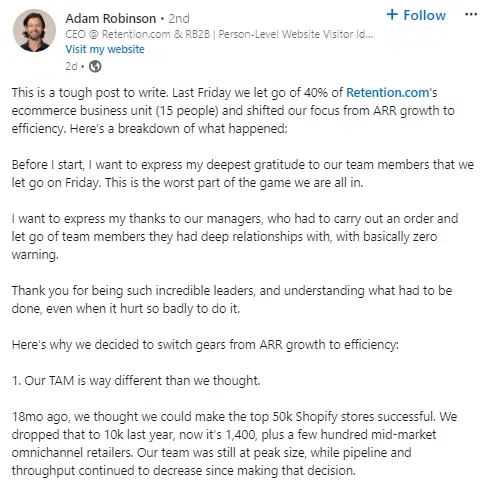How to identify high-churn personas in B2B and mitigate their risk
Here are the six types of people most likely to stop using a B2B product and how to handle them.
Last week, Adam Robinson, the CEO of Retention.com, published a LinkedIn post that’s become all too familiar over the last couple of years. You know the one. Retention.com had to let go of staff. In this case, it was 15 people, which is about 40% of the headcount.
These posts are met with a wide range of emotions, which is understandable. I’m not bringing it up to judge Robinson on his turn at this unfortunate ritual. Robinson, like many before him, used the opportunity to talk about the mistake he made at the helm of Retention.com.

He said the layoffs were because the company needed to switch focus from annual recurring revenue (ARR) to efficiency.
The company’s churn rate was a primary cause. Retention.com helps online retailers using Shopify re-engage lapsed audiences and abandoned shopping carts. Robinson described the churn problem as a result of being “in a high churn product category with a high churn buyer persona.”

I knew about high-churn products. They tend to be relatively inexpensive and easy to deploy, usually project-based tools or products that are relatively easy for competitors to replicate.
But I didn’t know as much about high-churn personas. So I looked into what they are and how marketers can mitigate their impact.
Dig deeper: 22 must-have reports for measuring CRM health
The 6 high-churn personas marketers need to watch closely
There are at least six high-churn personas marketers and sales teams need to watch closely.
The short-term project manager or consultant
Project-based work isn’t supposed to last forever. Consultants and project managers brought in to help guide a project to completion often need to buy tools to see the project through, but once it’s complete, they often disappear. That means there’s an increased likelihood of terminating the contract because the tool is no longer needed and/or its champion is gone.
You can mitigate this risk by ensuring the product offers ongoing value beyond the scope of the original product. You can also work to identify new champions. When a consultant or project manager moves on, someone is usually left with the project. Identifying and building a relationship with that person is key.
The cost-conscious decision-maker
As with many other types of selling, some areas of tech appear to be a race to the bottom. There are always leaders who prioritize low prices over the value products provide. The churn for this persona is high because they are likely to switch to lower-priced providers.
Robinson talked about competitors moving into Retention.com’s space. When businesses are trying to build a customer base, they often undercut the existing players in price. It’s not always a sustainable strategy, but if you’re the incumbent, that doesn’t really matter.
The antidote for cost-conscious decision-makers is emphasizing value and ROI. Tiered pricing structures will help accommodate cost-conscious buyers. It also provides a path for them to spend more when their business situation improves or a new decision-maker enters the organization.
Early adopters with high expectations
Think back to the early days of the martech market. There were thousands of applications, and marketers had cash to spend. The possibilities seemed limitless. Everyone was eager to adopt new technology and had high expectations for what that technology would do. This is what Gartner’s Hype Cycle is all about. At some point, reality sets in.
Early adopters with high expectations get disappointed when a product falls short and thus become more likely to churn.
You can mitigate this risk by managing expectations and communicating clearly with clients about product capabilities, the roadmap, and, of course, by offering exceptional customer support for those with high expectations.
Dig deeper: How to measure what matters in account-based marketing
The free trial user
There are certain categories of technology where many vendors use a product-led growth (PLG) strategy. Project management tools come to mind. If you’re like me, you’ve probably used many of the project management tools out there because marketing departments seem to cycle through the free trials from vendor after vendor until they expire.
Free trial users fail to convert to paying customers for several reasons, including:
- The free trial features are good enough.
- They don’t have the budget to move to a paid subscription.
- They don’t see enough differentiation between similar products in the category.
You can mitigate the high churn of free-trial users by optimizing the free-trial experience. Provide clear value propositions for an upgrade to paid versions. You can even incentivize conversions for free-trial users.
The company going through a significant change
Mergers, acquisitions, re-organizations and re-structures all lead to change. People, priorities and budgets change, as do the need and preferences for technology tools.
You can mitigate the risk with companies going through this by building strong relationships with key stakeholders. Flexible contract terms and proactive support can help too.
The dissatisfied customer
Perhaps the most familiar of the high-churn personas is the one who just isn’t happy with the product. It could be an issue with the product itself. It could be the support they received (or didn’t). In many cases, it’s both.
The frustration that builds from these experiences often leads to attrition.
Mitigation, in this case, falls mostly on customer success and support. The reps here need to be on their game, being proactive and seeking active feedback from the customer along the way.
The bottom line
If these high-churn customers are familiar to your organization, handle them with care. This isn’t a job for marketing alone. It involves the entire revenue organization, including sales and customer success.
MarTech is owned by Semrush. We remain committed to providing high-quality coverage of marketing topics. Unless otherwise noted, this page’s content was written by either an employee or a paid contractor of Semrush Inc.
Related stories